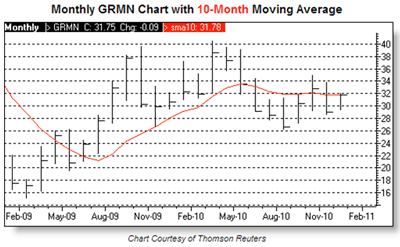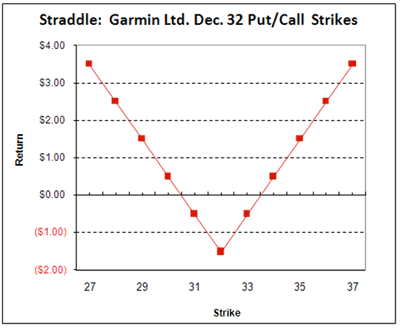An option straddle allows you to profit from a stock’s price movement, even when you aren’t sure which direction price will go. Essentially, you know a stock is going to move sharply but are unsure which way—up or down. For those not familiar with this options strategy, a straddle is the simultaneous purchase or sale of an equal number of puts and calls on a given underlying stock with the same expiration and strike price. The straddle purchaser is looking for a large move by the stock, one that exceeds the focus strike by more than the amount of the premium paid for both options.
Let’s take a look at an example. Garmin Ltd. (GRMN) has attracted quite a bit of attention lately, with the shares rallying more than 10% since November 30. However, this sharp rebound has pushed GRMN into former support/resistance at its ten-month moving average. While options activity has been light in response to this strong price action, one options trader appears to have entered a straddle on the security.
Drilling down on today's GRMN straddle, the trader purchased 72 December 32 calls for the ask price of $0.61, or $61 per contract, on the Chicago Board Options Exchange (CBOE) at 11:42 am eastern time. As you would expect with a straddle position, the other half of this trade crossed on GRMN's December 32 put, where 72 contracts changed hands at the same time on the same exchange for the ask price of $0.91. By implementing this strategy, the trader needs GRMN to move sharply by the time these options expire at the close of trading on Friday, December 17, and direction doesn't matter.
In today's GRMN straddle, the trader purchased 72 December 32 calls for $4,392:
($0.61 x 100) x 72 = $4,392
At the same time, the trader also purchased 72 December 32 puts for $6,552:
($0.91 x 100) x 72 = $6,552
The total outlay for this position would be $10,944 ($6,552 + $4,392 = $10,944)
There are two ways of determining the maximum profit on a straddle position. If GRMN jumps higher, then the maximum profit is theoretically unlimited, as there is no cap to how high the shares can rally. If GRMN plunges, the maximum profit is limited to the purchased strike minus the total debit paid. For this position, the maximum profit from a downside move is $30.48 ($32 – $1.52), or $3,048 per contract.
There are also two breakeven points for this position. They are calculated by adding and subtracting the net debit to or from the focus strike. For the example, the breakevens are $33.52 ($32 + 1.52), or $33.52 on the upside, and $30.48 ($32 – $1.52) on the downside. Finally, the maximum loss is limited to the net debit paid upon entering the position. Below is a chart for a rough visual representation:
Implied Volatility
Traders should not be afraid of rising implied volatility following the initiation of a straddle position. An increase in “implieds” boosts the value of the purchased options, allowing the trader to collect a higher return by selling (to close) the position. At the time of the trade, “implieds” for the GRMN December 32 call were 31.13%, while the implied volatility for the December 32 put rested at 34.11%. For comparison, the stock's one-month historical volatility arrived at 29.80% as of the close of trading last Friday (December 3).
By Joseph Hargett, contributor, Schaeffer’s Trading Floor Blog














